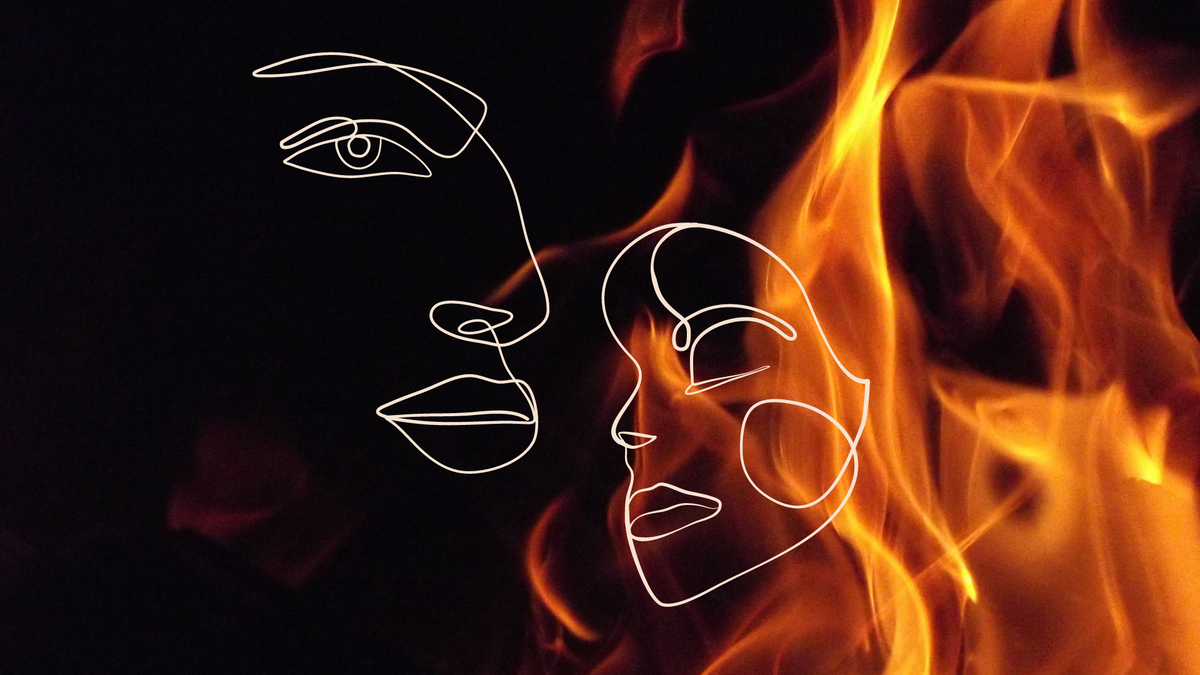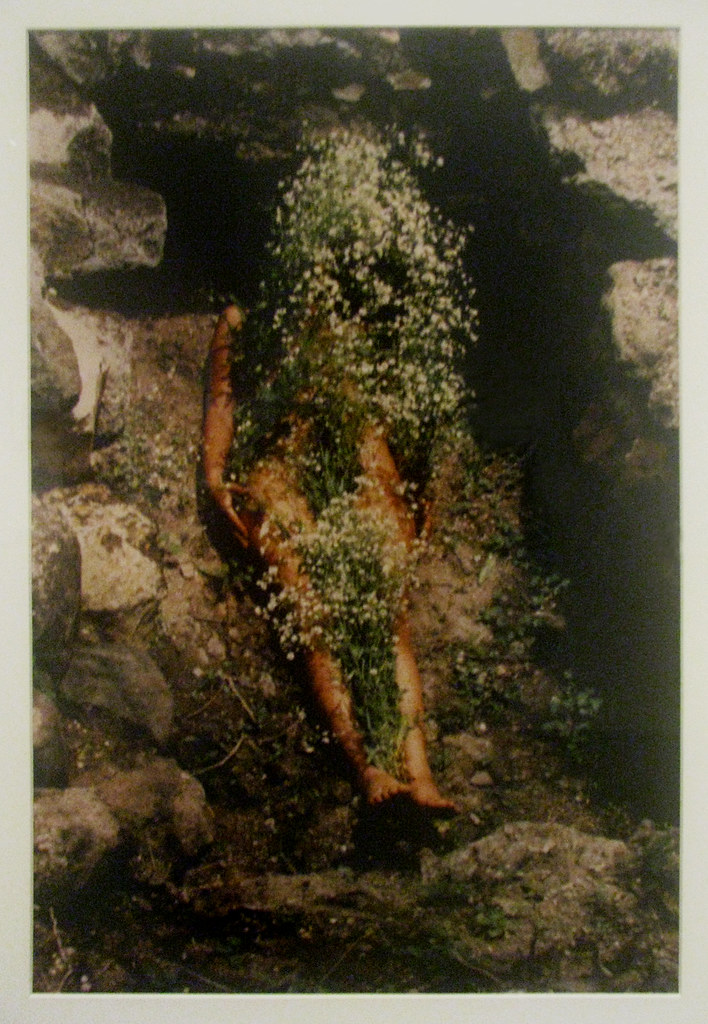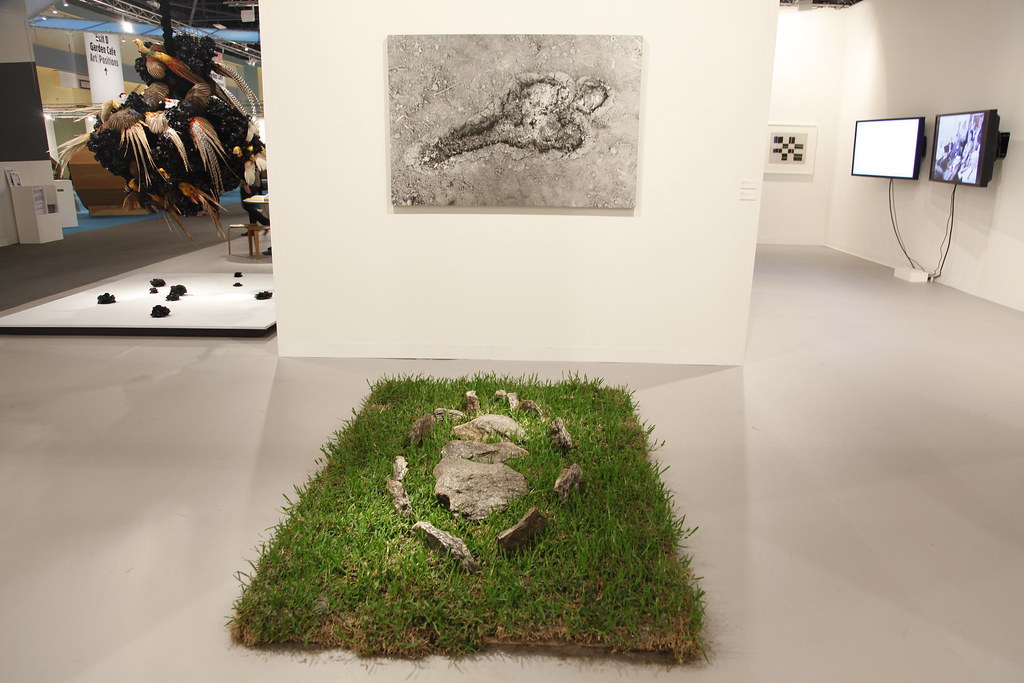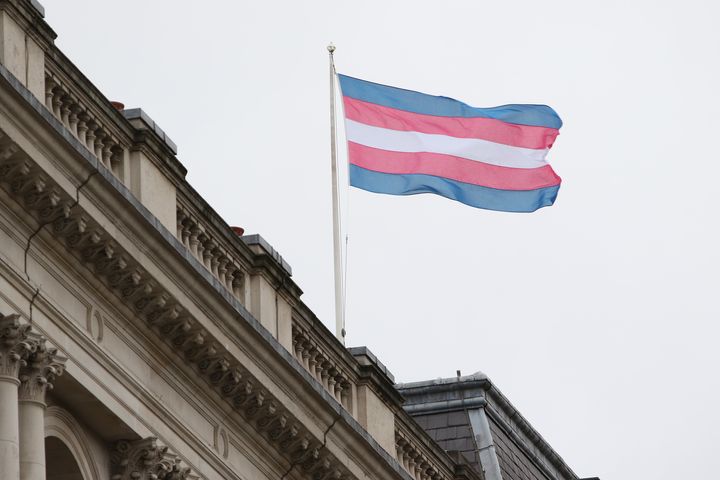Fire and Feathers: Ana Mendieta in Life and Death
The Cuban artists' work on male violence may have foretold her own murder

“N othing that she ever did ever surprised me,” Ana Mendieta’s sister, Raquelin, told The New York Times, “she was always very dramatic, even as a child - and liked to push the envelope, to give people a start, to shock them a little bit. It was who she was, and she enjoyed it very much.”
I wonder what passers-by thought of the foreboding 1973 short film, “Moffitt Building Piece,” where Mendieta poured pig’s blood on the cement sidewalk outside of her apartment and captured people’s reactions with Raquelin? Surely not that the woman who staged the artwork was predicting her own death.
Ana Mendieta was born in Havana, Cuba, into a family with a fair amount of political and social influence. When she was twelve, she was sent to the United States with fifteen-year-old Raquelin through what was called “Operation Peter Pan.” Operation Peter Pan was a U.S. government program enacted between 1960-1962 that involved “14,000 unaccompanied children [being] brought to the United States from Cuba… a covert program that helped school-age kids escape repression.”
The Cold War program was sanctioned by the Eisenhower administration and, while it was advertised as “helping the children,” it was motivated by anti-communist ideologies rather than human rights. The children were perceived differently to the detained asylum seeking children of today: it was convenient for the U.S. government to portray Cuban children as victims needing rescuing from the enemy. The problematization of asylum seekers today reveals how, historically, operations that encourage seeking asylum in Western countries are often propagandist. Look at the persuasive symbolism of using “Peter Pan” in the operation’s title, for example.
“I’m not interested in the formal qualities of my materials, but their emotional and sensual ones.”
The experience wasn’t exactly Disney magic for Ana Mendieta and the rest of the fourteen thousand children, however. Despite the U.S. encouraging this migration, Ana and Raquelin were placed into a refugee camp for weeks once they arrived in the U.S, before being pinballed between foster homes and orphanages, lasting for years. Many children were separated from their siblings; Ana and Raquelin were only allowed to stay together due to a power of attorney signed by their parents. Ana was reunited with her mother and younger brother in 1966, the year she started a painting degree at the University of Iowa. Her father didn’t arrive in the U.S. until 1979, after spending 18 years in prison.
Mendieta found an affinity with feminist artists like Carolee Schneemann and boundary-pushing art groups like Fluxus. The Guggenheim’s online collection website states that Mendieta “quickly developed a prolific practice in which her body, the earth, and other organic materials such as blood, fire, feathers, and wood served as the subject of photographs, slides, films, and videos, as well as performances, prints and artist’s books.” Emily LaBarge wrote in The Paris Review that during the time Mendieta acted as examiner during LaBarge’s PhD, she passed her a note: “I’m not interested in the formal qualities of my materials, but their emotional and sensual ones.”
Mendieta’s work opened a discourse about male violence against women. In 1973, Mendieta began Silueta Series (1973-80), where she placed her body (literally or through impressions) in various outdoor sites in Mexico and Iowa, and documented it through photography or film.
In Silueta Series, the female body’s romantic connection to the environment, or Mother Earth, forebodes a concern with premature mortality. The image of Mendieta lying down in a grave-like hole with flowers growing through her body, her arms placed straight down her side —as if she was murdered and arranged like this some time ago— is not an unfamiliar scene. It is a scene similar to where my imagination goes when I hear yet another woman has been murdered by a man and hidden in bushland. I don’t think Mendieta prophesized her own individual downfall. Collective downfall of women, including our own safety, is and was a concern for many of us, all of the time. The theme of female mortality in the series isn’t even necessarily literal, it speaks to the decay of female self, body, and soul under capitalist patriarchy.

Mendieta didn’t die in nature, however. Not the scenic environments in Silueta Series, or Cuba, where she was extracted during Operation Peter Pan to be forever-young in Neverland, no. She died in the capitalist mecca of New York, landing on top of a deli roof after descending over 30 stories in 1985. We know that leading up to her death, Mendieta’s husband, Carl Andre, wrote poetry fantasizing about pushing Mendieta out of a window. We know Andre had fresh scratch marks on him when the police arrived. We know a female voice saying “No! No! No!” was heard by some people nearby, including the doorman, who heard her hit the roof. We know Andre’s statement changed many times. We know Andre was originally charged with second degree murder. We know he opted for a juryless court, instead of being judged by his peers. We know he was acquitted.
We also know that Carl Andre called 911 after Mendieta “went” out of the window. He told the operator:
“What happened was we had - my wife is an artist and I am an artist and we had a quarrel about the fact that I was more, eh, exposed to the public than she was and she went to the bedroom and I went after her and she went out of the window.”
Even if we entertain the unlikely idea that it was suicide, despite no fingerprints being found on the windowsill, it was still a murder inflicted by capitalist patriarchy. It was a patriarchal government that used her to promote ideological propaganda when she was a child. The same government, which was supposed to take care of her, then ordered that she be thrown into foster homes, orphanages, and refugee camps for years. The same government expected her to assimilate into the U.S. way of life, as if the U.S. is inherently superior to Cuba, which would have disrupted her concept of self. Then, after all of that, she entered a relationship with a violent man—regardless of how she “went” out of the window.
Earlier this year, actress Ellen Barkin tweeted about her experience with Carl Andre’s violent nature:
“I was a 22 [year] old waitress working a party for painter Carl Andre...Andre got angry over his service. Shoving me against a wall, his hands around my neck pulling me up [until] my feet left the floor. 3 men got him off me...Years later Andre’s wife died ‘falling’ out of a window…There were signs of a violent fight, a woman screaming No! No! No! Andre was charged with second degree murder. He was acquitted of all charges. #BelieveWomen.”
Many men love Carl Andre. In an interview with Richard Serra, Andre is greeted with an, “Oh Carl, I didn’t recognize you,” and Andre jokes in return, “I’m like Cuba, nobody recognizes me.” What a strange thing to say in 2011 when Ana Mendieta, a Cuban woman very affected by its tensions with the US, “went” out of a window in 1985 while you were the only one present? After an argument where she can be heard saying “No! No! No!” before falling to her demise? Especially when, in his call to 911, which you could call a premature start on his statement, Andre claimed the very thing they were fighting about was that he was recognized, he was more “exposed to the public than she was.” Why bring up Cuba, of all places?
The reality is that Andre is recognized for his so-called “genius” and he is still “exposed to the public,” at 85-years-old. Not only has Andre been shown in reputable museums and galleries since the 1960s and even shared a studio with Frank Stella, Andre’s “genius” work only ended its five-year worldwide tour about four years ago. He’s a rockstar to many male artists, curators, fans and institutions. At the Museum of Contemporary Art (MoCA) in Los Angeles, the tour’s final destination, the opening of Andre’s work “wasn’t well attended,” according to Maya Gurantz. Then again, there was “little to no advertising of the show.” Perhaps that’s because many women are still furious over Ana Mendieta’s death, demonstrated by the “protestors on the outside [of the opening] and angry women walking beside embarrassed boyfriends on the inside.”
“Not only has Andre been shown in reputable museums and galleries since the 1960s and even shared a studio with Frank Stella, Andre’s 'genius' work only ended its five-year worldwide tour about four years ago.”
Carl Andre doesn’t need advertisement. That’s the point. He doesn’t even need people to attend exhibitions of his work. Whether or not his legion of male followers make it to the opening—with their own reputations on the line—or they sneak in to view the exhibition on their lunch break, without their wives or girlfriends, it doesn’t mean much at all. Not only may they view or buy his work in secret, they definitely share a secret: the boy’s club. It’s time we stopped pretending that the boy’s club is just innocent fun between lads and doesn’t perpetuate violence against women. Let’s not forget that Men’s Rights Activists and Incels actually live in the real world too, not just online, and their numbers are enormous.
Elliot Rodger, the misogynist who killed ten people in Canada, posted to Facebook before the murders: “The Incel Rebellion has already begun! We will overthrow all the Chads and Stacys! All hail the Supreme Gentleman Elliot Rodger!” This victim mentality of “women won’t sleep with me” and “I’m so misunderstood” is evident among misogynists, both online and offline. So forgive me if I am sensitive to the fact that Andre conflates himself with Mendieta’s country-of-origin, Cuba, and says “nobody recognizes me,” like a petulant child. Let’s all weep for Carl Andre, the successful and well-recognized 85-year-old man who still strangled Ellen Barkin (needing 3 men to pull him off her) regardless of the suspicious circumstances of Ana Mendieta’s death. He is not a victim and staging himself as one is a common tactic used by abusive men.
Yes, male artists are not exempt from engaging in locker-room misogyny. Or from killing their wives, girlfriends, or women on the street. The “sensitive” male artist who sweeps the woman off her feet in romantic comedies is not a true reflection of patriarchy’s pervasive nature into any crew of men. David Bowie raped (it’s not just sex if she’s 15, bro) 15-year-old Lori Maddox when he was 25, but he’s still considered a hero. Another male “genius.” If you want an androgynous musician of that era to stan then look into Joan Jett or Suzi Quatro. He’s not the only gender non-conforming musician out there. Bowie wasn’t the catalyst of gender nonconformity, either. Why does a man have to wear a suit for even feminists to see the misogyny? Marilyn Manson, whose ex-fiancé Evan Rachel Wood claims “manipulated her into submission” and then inflicted physical and sexual abuse against her, is not one to look up to either. Manson maintains that her claims are a “horrible distortion of reality,” but the normalization of violent sex does not make the violence any less real or traumatic. “I’m a sensitive male artist, unlike those mean, meat-head jocks,” is pretty similar to mass-murderer Elliott Rodger’s “misunderstood gentleman” manifesto.
“Like Manson and Bowie, the facade of the art world is progressive but, behind closed doors, powerful males are intent on keeping things exactly as they always have been: about men.”
The mythical “sensitivity” of male artists means men like Carl Andre go undetected because they’re not on a football field or doing keg stands. Tate Modern director Frances Morris, the first female director of the museum, says the art world has a “bias” against women and that it is definitely “a boys’ club.” In her work as a curator at Tate since 1988, Morris has succeeded in bringing female artists such as Yayoi Kusama, Agnes Martin, and Louise Bourgeois to the stage. Morris claims that part of the misogyny in the art world is that there is a “deep conservatism institutionally.” Like Manson and Bowie, the facade of the art world is progressive but, behind closed doors, powerful males are intent on keeping things exactly as they always have been: about men.
Carl Andre’s devoted male followers claim he’s already been punished enough. They claim he’s been ostracized, despite doing a world tour of his art when he was over 80-years-old. He hasn’t been dead for 36 years like Mendieta. Maya Gurantz argues that Calvin Tomkins’ New Yorker article about Richard Serra’s interaction with Carl Andre, where he conflates himself with Mendieta’s “unrecognizable” homeland, Cuba, heroicized Andre. It portrayed him as an “unrecognizable” victim of Mendieta’s death, not because he is sad she’s dead—he doesn’t seem so—but because the “event” might have slightly eclipsed his reputation. Tomkins defends Andre:
“It is hard to think of an artist whose career has been so affected by circumstances that have nothing to do with his art. In Andre’s case, the precipitating event was the death of his third wife, Ana Mendieta, a young artist who fell from the bedroom window of Andre’s apartment, on the thirty-fourth floor of a high-rise on Mercer Street, in the early-morning hours of September 8, 1985. Andre was charged with murder, indicted, and eventually acquitted in a non-jury trial, but Mendieta’s family and many of her friends in the art community and the feminist movement believe that he was responsible for her death.”
Forget violence against women, what about the man’s art!?
Ana Mendieta was not an emotionally closed-off person, it’s evident in her art, so doesn’t it ring alarm bells that those closest to her don’t believe it could have been suicide?
Carl Andre has proven to be violent outside of his interactions with Ana Mendieta. What makes him “bad enough?” Gurantz asks Tomkins, Andre, and his followers, who all claim he’s been pushed out, “where [was he pushed out of]? Not out of a window, surely.” He hasn’t even been pushed out of the art world: she reminds them of his “Guggenheim appearances, his loyal gallerist selling millions of dollars of work to blue chip collectors…[his] retrospective now coming to MoCA at the end of a six-year-long worldwide tour.” He doesn’t need to advertise because he already has male artists and writers sponsoring him. He benefits from the boy’s club. What if he was a woman? Ana Mendieta can’t make art. She’s dead.
"Carl Andre shouldn’t be 'cancelled.' He should be in prison."
Andre’s work is relevant and recognizable to many male artists, collectors and fans. The museums who host his work might claim they are not a court of law, but women are fired from their jobs, or threatened where they work—institutions—for having conviction in the face of censorship. Perhaps we’re not as desensitized to women speaking up as we are to male violence. That’s horrifying.
Carl Andre shouldn’t be “cancelled.” He should be in prison. Regardless of Ana Mendieta’s death, he has a history of violence against women. He didn’t defend freedom of speech or say something in an unpalatable way, he strangled a woman until she was lifted off the floor and it took a group of men to stop him doing it. He wrote poetry about pushing a woman out of a window, who just so happened to “fall” out of a window when he was the only one present. Why aren’t we talking about him instead of unpalatable feminists?
Museums have played a role in cementing Andre’s “genius” status in art history. His memory will be glorified unless women fight for the past, present, and future Ana Mendietas. Gurantz outlines that Andre’s supporters (including museums):
“Weave together the belief in Andre’s innocence with the caveat that, even if he isn’t innocent, it doesn’t matter. Proper respect for his art-making has been darkened by this event [Mendieta’s death], which had nothing whatsoever to do with his art-making. And that’s not fair. Because Carl Andre is a ‘genius’.”
They are desperately trying to garner sympathy for the poor old man before he dies with a marred reputation. They are quickly trying to shove him in the “genius” canon without valuing the truth of his character or behaviour. Tomkins urges people to see Carl Andre’s art outside of who he is, or what he’s done, while spending the entire article garnering sympathy for him and portraying him as a misunderstood, “unrecognized” victim… which contradictively focuses on “who he is” and not “his art.”
Mendieta’s death needs to be talked about and not only because of the widespread suspicion that Carl Andre did it. Mendieta’s art, her life, and her death, represent the experiences of many women. It represents a divide in the art world, between the boys club misogyny—which hasn’t gone away, it’s just more secretive—and female liberation. It represents the experience of immigrant women and women of color who are used as pawns for ideological purposes. It represents the silencing of powerful women.

Mendieta was not a wallflower. She even staged a performance piece called Untitled (Rape Scene), in response to the brutal rape and murder of a nursing student named Sara Ann Otten, by another student, in 1973. Mendieta was a woman who actively and unapologetically challenged patriarchy and patriarchal thinking. She was not a martyr; she was a resistor. The violence women experience is not because of their choices in male partners, male friends, male family, or otherwise. Men need to take accountability. Including the bystanders who protect violent men by attempting to rebrand them. Including those who stay silent.
Ana Mendieta predicted her own death through her art and it wasn’t because she was a psychic—that claim wouldn’t do her justice. She predicted it, indirectly, by exposing patriarchal trends we like to keep hidden. She did it through telling her own and other women’s stories. Her death is part of a trend; it is not an anomaly.
When Mendieta poured pig’s blood on the cement outside of her apartment, she tested people’s reaction to violence. Violence happens against women at the hands of men so often that we’re desensitized to it as a society. Mendieta’s story wrote itself before she was born. It’s been written since the dawn of patriarchy. She wasn’t just “unlucky.” Ana Mendieta’s life and death reflects the reality of women’s lives and deaths from all over the world.
The generous support of our readers allows 4W to pay our all-female staff and over 50 writers across the globe for original articles and reporting you can’t find anywhere else. Like our work? Become a monthly donor!
Enter your email below to sign in or become a 4W member and join the conversation.
(Already did this? Try refreshing the page!)





Comments